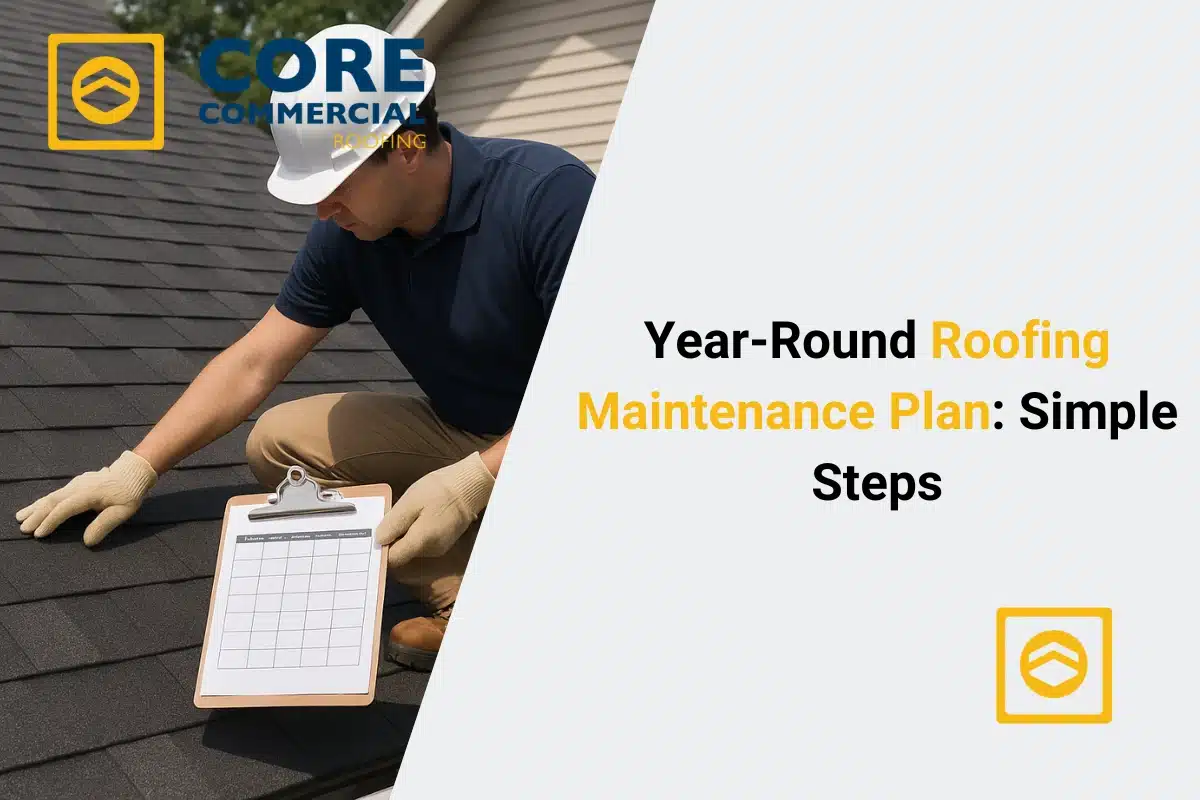Your roof works every day of the year to protect your building, yet many property owners only think about it when a leak appears. A year-round roofing maintenance plan is the smartest way to prevent costly damage, extend roof life, and keep repair bills under control. A great strategy is scheduling seasonal inspections, because they reveal small issues like cracks, loose flashing, or clogged drains before they grow into emergencies. When maintenance is consistent, your roof performs better during storms, heavy rains, and extreme heat. In this article, you’ll learn how to build a simple but effective roofing plan that works in every season. By following these steps, you’ll save money, reduce stress, and avoid surprises. Keep reading to see how year-round care can keep your roof strong for decades.
Table of Contents
Why Year-Round Roofing Maintenance Matters
Roofing is not just about shingles or coatings—it’s about protecting everything beneath them. Without regular care, a roof loses efficiency and strength. Over time, weather, debris, and age wear down materials. Small cracks, leaks, and water pooling may not seem urgent at first, but can cause expensive structural damage if ignored.
A maintenance plan ensures every part of your roof—from gutters to flashing—stays in good condition. The main goal is prevention. By spotting minor issues early, you avoid roof leaks, mold growth, and costly interior repairs. Many insurance companies even require proof of maintenance before approving claims, making routine care not only smart but also financially beneficial.
Common Problems Caused by Neglect
Ignoring a roof does not make problems go away. Small damage often snowballs into serious issues. Here are the most common results of skipping maintenance:
- Leaks and Water Damage – Even tiny cracks allow moisture inside, leading to rot and mold.
- Clogged Gutters – Blocked drainage pushes water back under shingles or membranes.
- Premature Wear – UV rays, heat, and storms cause materials to age faster without upkeep.
- Pest Infestations – Openings in roofing materials give birds, rodents, and insects easy access.
- High Energy Bills – Damaged insulation or reflective surfaces increase heating and cooling costs.
Most of these problems could have been prevented with routine checkups and simple cleaning.
Seasonal Roofing Checklist
A roof experiences different stresses throughout the year. That’s why a seasonal checklist is one of the best tools for property owners. By dividing maintenance into seasons, you ensure no task is missed.
Spring Maintenance
After winter, spring is the time to check for cold-weather damage. Look for broken shingles, damaged flashing, and clogged gutters. Snow and ice may have left behind moisture damage. Cleaning debris, trimming overhanging branches, and inspecting seals around vents should all be part of the spring checklist.
Summer Maintenance
Summer heat can weaken roofing materials, especially in hot climates. Inspect for blistering, cracking, or warping surfaces. This is also the best season for a professional inspection, since conditions are dry and repairs can be completed without weather delays.
Fall Maintenance
Before winter arrives, prepare your roof for harsh weather. Clean gutters to handle heavy rain or snow melt. Check insulation and attic ventilation to reduce ice dam formation. Replace worn shingles and ensure flashing is sealed tightly. Preventive care in the fall can save thousands in winter damage.
Winter Maintenance
Winter requires vigilance but limited roof walking. Instead of climbing on the roof, check ceilings for signs of leaks, monitor attic insulation, and ensure gutters are clear before snowfall. If heavy snow builds up, hire professionals to safely remove it.
The Importance of Regular Roof Inspections
Regular inspections are the backbone of a roofing maintenance plan. Many experts recommend at least two per year—once in spring and once in fall. These inspections uncover problems that are hard to see from the ground.
Our preferred method is a professional inspection because roofing experts know what to look for. They check hidden areas like flashing, valleys, and seals. They also provide detailed reports that help with insurance claims or future maintenance planning.
Cleaning Gutters and Drainage Systems
Gutters are often overlooked, yet they play a major role in roof protection. Clogged gutters trap water, which seeps under shingles or roofing membranes. Over time, this creates leaks and weakens the roof structure.
Cleaning should be done at least twice a year—once in spring and once in fall. In areas with heavy tree cover, quarterly cleaning is even better. Installing gutter guards can reduce cleaning needs, but inspections are still necessary to ensure water flows freely.
Roof Surface and Material Care
Different roofing materials require different levels of care. Asphalt shingles, metal, tile, and flat roofing systems each respond to weather in unique ways. For example:
- Asphalt shingles need regular checks for curling, cracking, or missing sections.
- Metal roofs should be checked for rust spots, loose fasteners, or sealant wear.
- Tile roofs can crack under weight or impact, requiring replacement pieces.
- Flat roofs must be cleared of pooling water and checked for punctures.
Routine cleaning and minor repairs extend material life and improve roof performance.
Checking Flashing, Seals, and Penetrations
Areas where the roof meets walls, chimneys, vents, or skylights are the most common sources of leaks. Flashing and seals protect these vulnerable spots, but they wear out faster than other roofing parts.
Regular inspection ensures flashing is secure and caulking has not dried out or cracked. If ignored, water can enter the structure, causing serious damage to insulation and framing.
How Weather Impacts Roofing Systems
Roofs face constant challenges from the weather. Sun exposure causes fading and brittleness. Heavy rain leads to leaks and mold. Wind loosens shingles or lifts edges of membranes. Snow adds heavy weight, and ice dams block drainage.
Understanding how the weather affects your roof helps you prepare. A strong maintenance plan accounts for local climate and schedules repairs before weather events become disasters.
Energy Efficiency and Roof Maintenance
A well-maintained roof saves money on energy bills. Damaged or poorly sealed roofing materials allow hot or cold air to escape, forcing HVAC systems to work harder. Reflective coatings, proper insulation, and ventilation all play a role in efficiency.
Regular maintenance ensures these systems function as designed. Even small repairs—like sealing gaps or replacing insulation—can improve comfort inside the building and reduce utility costs.
Choosing a Maintenance Schedule That Works
Not all roofs need the same schedule. Age, material type, and local weather determine how often maintenance is needed. Older roofs may require quarterly inspections, while newer installations may be fine with twice-a-year checkups.
Consistency is key. Whether you handle tasks yourself or hire professionals, create a written schedule and stick to it. This ensures nothing gets overlooked.
Preventive vs. Reactive Roofing Costs
Preventive maintenance is always less expensive than emergency repairs. A small investment in inspections, cleaning, and sealing can prevent thousands of dollars in leak damage or roof replacement costs.
Reactive care—waiting until something breaks—leads to higher repair bills, business interruptions, and property damage. Preventive plans save both money and stress.
Benefits of Documenting Your Roof Maintenance
Keeping records of inspections and repairs provides several benefits:
- Proof for insurance claims
- Better resale value of the property
- Easier planning for future roof replacement
- Accountability for contractors or maintenance staff
A simple log with dates, notes, and receipts is enough to track roof history.
Safety Precautions During Roof Work
Climbing onto a roof is dangerous without proper equipment and training. Always use ladders safely, wear non-slip shoes, and avoid roof work during wet or windy conditions. For most inspections and major cleaning tasks, hiring a professional is the safest and most effective option.
When to Call a Professional Roofer
DIY maintenance works for tasks like gutter cleaning or ground-level inspections, but more complex work requires expertise. Call a professional roofer when you notice:
- Persistent leaks
- Sagging roof areas
- Extensive storm damage
- Worn-out flashing or seals
- Large amounts of moss or algae
A licensed roofer provides accurate assessments and safe repairs.
Long-Term Benefits of a Maintenance Plan
A structured year-round maintenance plan pays off in multiple ways. It extends roof lifespan, protects property value, reduces repair costs, and keeps insurance coverage secure. Most importantly, it provides peace of mind knowing your roof is ready for any season.
Final Thoughts
Creating a year-round roofing maintenance plan is not complicated, but it does require consistency. Seasonal checklists, professional inspections, and preventive care keep your roof in excellent condition. One of the simplest yet most powerful steps is scheduling inspections twice a year, as they uncover hidden issues before they become disasters.
By making roof maintenance a regular habit, you protect your property, save money, and enjoy worry-free seasons. A strong roof means a stronger building, and with the right plan in place, you’ll have protection that lasts for decades.
FAQs
How often should I inspect my roof yearly?
Most homeowners should inspect their roof at least twice a year—once in spring and once in fall—to catch small issues early, like missing shingles, flashing problems, or leak,s before they become expensive repairs. When a homeowner follows this in‑depth approach, they often avoid bigger damage that can cost thousands






